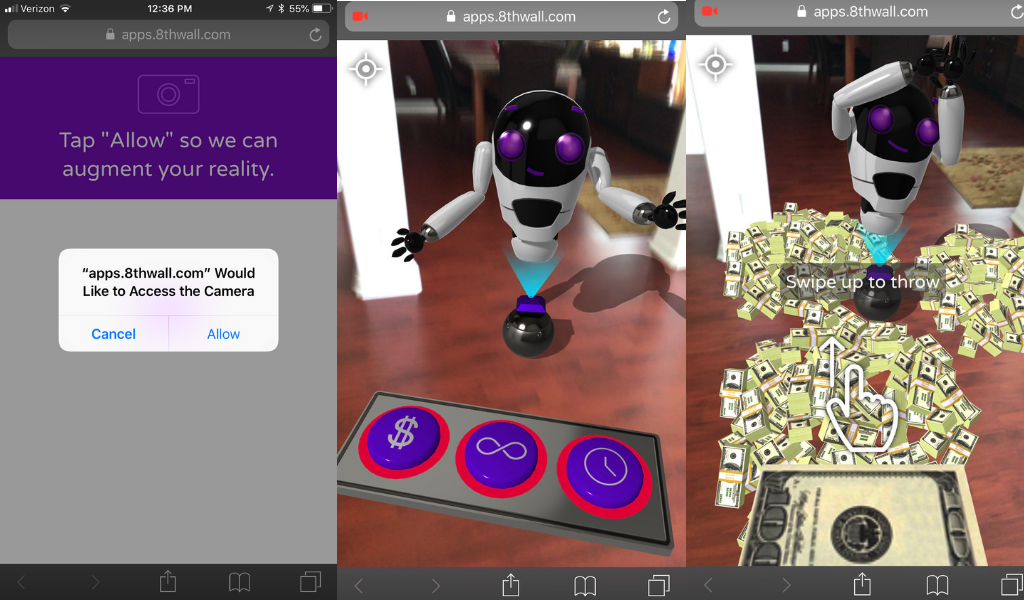As AR developers can attest, their creative application innovations are limited to mobile devices running ARKit or ARCore, and entail timely porting from platform to platform, as well as the frustrations that come along with it. The company 8th Wall is ready to offer a service set to revolutionize AR from both the frontend and the backend of this technology, making development both quick and seamless.
Their initial product offering, 8th Wall’s XR Platform allows developers the convenience of creating a markerless AR application, and then distribute it to any iOS or Android mobile device, both current and older models, with or without native AR libraries. This is the first native-integrated, cross-platform developer solution for mobile AR.
Their newest product, releasing today, will bring augmented reality to websites, where AR experiences are immediately accessible for a majority of mobile users.
Background
8th Wall is a heavily funded startup led by founder and CEO, Erik Murphy-Chutorian, a former Facebook and Google engineer. Founded in 2016, and headquartered in Palo Alto, California, the company’s team of 9 believes that augmented reality is for everyone, no matter what device they happen to be on.
They are targeting general purpose AR development, including gaming, and their focus is solely on accelerating overall adoption of mobile AR.
As Erik told ARPost in an exclusive interview, “I really believe as a whole, that we’re moving to a world where technology is immersive, and you interact and engage with it. The hope is, ‘how can I make this happen faster and really push this industry forward?’ And that is when I started 8th Wall.”
The 8th Wall XR Platform – AR Deployment Made Easy
Using 8th Wall’s XR Platform, AR app developers can now build and deploy mobile apps in minutes to both iOS and Android devices simultaneously. Their 6DoF camera tracking and instant world tracking computer vision technology makes it quick and easy to build full AR experiences compatible with billions of iOS and Android devices, not just the limited subset that supports ARKit or ARCore.

Currently, the 8th Wall XR platform is completely free for both personal and professional use. There may be some fees for premium features in the future, but right now, 8th Wall wants to continue to be of service to AR developers creating amazing things that’s reachable to a more sizeable audience. With 8th Wall, augmented reality applications can now run across more than 2.5+ billion smartphones, dramatically expanding the market reach.
8th Wall has also integrated its technology into existing development platforms such as the Unity3D game engine, via plug-in, and provides extreme ease of use for developers by simply downloading an SDK package from 8th Wall’s website, importing it into a Unity project, and adding minimal scripts to some of the objects in the scene.
Erik also mentioned that having just released this platform in February, there are already 500+ active monthly developers who are building products with 8th Wall XR, and continues to grow monthly.
With over $10.4M in total funding, 8th Wall plans to accelerate development and product engineering. Their newest product offering is the next step in this process.
New Release of 8th Wall Web – AR on Websites
 8th Wall Web is unleashing augmented reality from the app marketplace to the web, which means it will be entirely device agnostic, and targeting both brands and agencies. Any existing website can now include AR features that are immediately accessible by smartphones with a camera and web browser.
8th Wall Web is unleashing augmented reality from the app marketplace to the web, which means it will be entirely device agnostic, and targeting both brands and agencies. Any existing website can now include AR features that are immediately accessible by smartphones with a camera and web browser.
Built using 100% standards-compliant JavaScript and WebGL, 8th Wall Web is a complete implementation of 8th Wall’s Simultaneous Localization and Mapping (SLAM) engine, hyper-optimized for real-time AR on mobile browsers. 8th Wall SLAM is a proprietary computer vision tracker that automatically kicks in if a developer is not using ARKit or ARCore.
8th Wall Web features include:
- 6DoF Positional Tracking: Allows the user to explore their space and interact with AR content using only their smartphone camera.
- Surface Detection: Allows detection of the ground or other flat surfaces such as tables for precise virtual object placement.
- World Points: Points in the world can be detected and used by an AR experience for visualization.
- Hit Tests: Enables interaction with points and detected surfaces in a scene.
- Lighting Estimation: Lighting levels in the user’s real world can be used to match lighting in an AR scene.
Erik was kind enough to showcase an AR experience demo of “JINI” to me, the magical robot that showcases game object interaction, animation, buttons to press that change to different types of mini-game scenarios, and more. It was created by 8th Wall’s team to highlight what is possible with AR on the web as they begin speaking with partners who will begin to use this technology.

Brand Use Cases for 8th Wall Web and a Significant Push for Mass Adoption
The possibilities for businesses to create immersive content for everyone is now a reality. Imagine 3D content embedded within company blog articles to better enhance storytelling. Or, the ability for users to preview items in their real world environment without having to download a separate mobile application. Online advertisements can allow users to engage and interact with their favorite brands, including embedded AR content within newsletters and promotional emails.
What This Means for AR Users Everywhere
Until now, AR experiences required the use and recognition of visual cues, images, or QR codes, known as marker-based AR, within a user’s physical environment. Or, AR itself required a user to download an app, which has been a major barrier in AR mobile adoption.
“In the US, 87% of smartphone users don’t download any mobile applications in a month,” says Erik to ARPost, regarding this challenge to mass AR adoption.
Most people’s first experiences with AR will happen on mobile, and mobile AR will undoubtedly be the catalyst for growth in a wide range of industries. 8th Wall will have a much further outreach, providing more opportunities to extend to customers on a scale that wasn’t possible before.
Closing Notes
As the AR market continues to grow and expand, the applications being developed should meet users’ needs more quickly and efficiently that ever before. By allowing developers to not only build for augmented reality across all platforms, but by now providing the ability to have users interact with these experiences through the web, 8th Wall plans to solve the current AR development problems by kickstarting the AR ecosystem.




